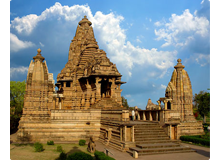Khajuraho
 The Khajuraho Group of Monuments in Khajuraho, a town in the Indian state of Madhya Pradesh, located in Chhatarpur District, about 620 kilometres (385 mi) southeast of New Delhi, is one of the most popular tourist destinations in India. Khajuraho has the largest group of medieval Hindu and Jain temples, famous for their erotic sculptures.
The Khajuraho Group of Monuments in Khajuraho, a town in the Indian state of Madhya Pradesh, located in Chhatarpur District, about 620 kilometres (385 mi) southeast of New Delhi, is one of the most popular tourist destinations in India. Khajuraho has the largest group of medieval Hindu and Jain temples, famous for their erotic sculptures.
Between 950 and 1150, the Chandela monarchs built these temples when the Tantric tradition may have been accepted. In the days before the Mughal conquests, when boys lived in hermitages, following brahmacharya until they became men, they could learn about the world and prepare themselves to become householders through examining these sculptures and the worldly desires they depicted.
The name Khajuraho, ancient "Kharjuravahaka", is derived from the Sanskrit words kharjura = date palm and vahaka = "one who carries". Locals living in the Khajuraho village always knew about and kept up the temples as best as they could. They were pointed out to the English in the late 19th century when the jungles had taken a toll on the monuments. In the 19th century, British engineer T.S. Burt arrived in the area, followed by General Alexander Cunningham. Cunningham put Khajuraho on the world map when he explored the site on behalf of the Archaeological Survey of India and described what he found in glowing terms. The Khajuraho Group of Monuments has been listed as a UNESCO World Heritage Site, and is considered to be one of the "seven wonders" of India.
The Khajuraho temple complex offers a professional light and sound show every evening. The first show is in English language and the second one in Hindi. The show is about an hour long and covers the history, philosophy and the art of sculpting of these temples. It is held in the open lawns in the temple complex. The Khajuraho Dance Festival, held every year in the first week of February (1st to 7th), is an opportunity for visitors to experience various classical Indian dances set against the backdrop of the Chitragupta or Vishwanath Temples. The M P Tourism Development has set up kiosks at the Railway Station (which is 9 km away from the city), with helpful tourist officers to guide the travelers. The temples in Khajuraho are broadly divided into three parts : the Eastern group, the Southern Group and the Western group of temples of which the Western group alone has the facility of an Audio guided tour wherein the tourists are guided through the seven eight temples. There is also an audio guided tour developed by the Archaeological Survey of India which includes a narration of the historical data related to the temples.











 Manali
Manali

